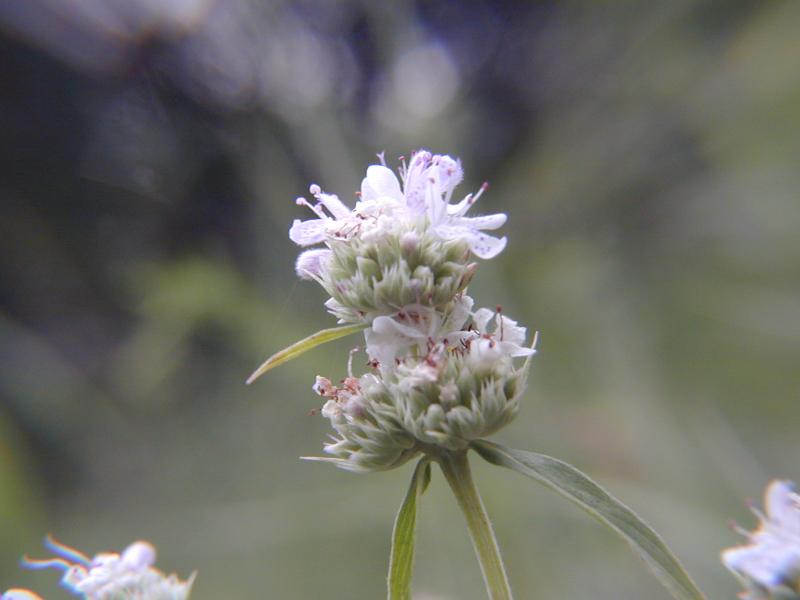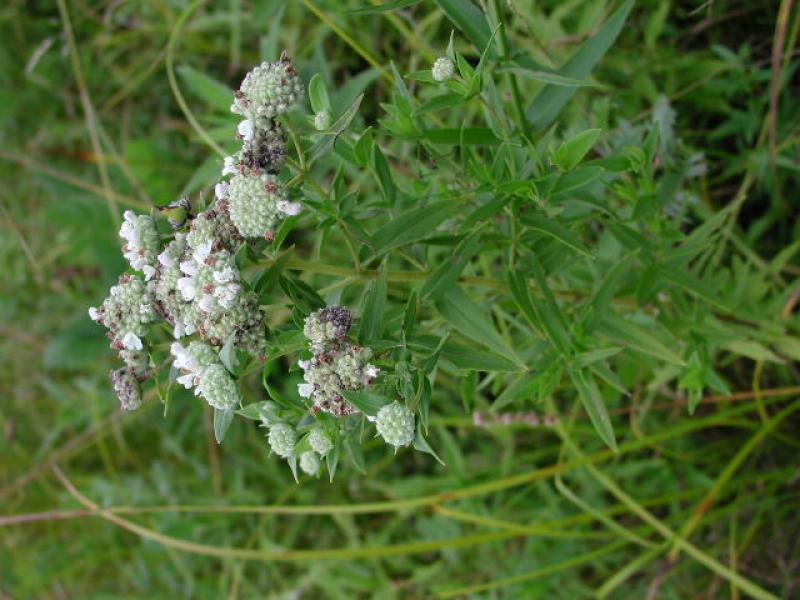Whorled Mountain Mint
Pycnanthemum verticillatum var. verticillatum None
- Class
- Dicotyledoneae (Dicots)
- Family
- Lamiaceae (Mint Family)
- State Protection
- Endangered
Listed as Endangered by New York State: in imminent danger of extirpation in New York. For animals, taking, importation, transportation, or possession is prohibited, except under license or permit. For plants, removal or damage without the consent of the landowner is prohibited.
- Federal Protection
- Not Listed
- State Conservation Status Rank
- S1S2
Critically Imperiled or Imperiled in New York - Especially or very vulnerable to disappearing from New York due to rarity or other factors; typically 20 or fewer populations or locations in New York, very few individuals, very restricted range, few remaining acres (or miles of stream), and/or steep declines. More information is needed to assign either S1 or S2.
- Global Conservation Status Rank
- G5T5
Secure globally - Both the species as a whole and the subspecies/variety are common in the world; widespread and abundant (but may be rare in some parts of its range).
Summary
Did you know?
The leaves of all Pycnanthemum species have a strong mint fragrance that can even be smelled in museum specimens decades old. Many members of the genus have been used medicinally to treat digestive and other disorders.
State Ranking Justification
There are only 4 verified occurrences and 5 historical occurrences known in New York.
Short-term Trends
More work is needed to determine the short-term population trends for this species, as most verified occurrences are small and have only been visited once.
Long-term Trends
There are equally small numbers of both historical and verified populations for this species in New York. It has likely always been rare in the state, though some populations have been overlooked.
Conservation and Management
Threats
Ditching and spread of the invasive grass species Phragmites australis are threats at one of the fen sites. Succession and ATV use are potential threats at both the fen and dune sites.
Conservation Strategies and Management Practices
Mowing or clearing, if done after the growing season, may benefit this species at sites which are succeeding to woody vegetation.
Habitat
Habitat
In New York, Whorled Mountain-mint has been found in fens, inter-dunal swales, and other open, calcareous wetlands, usually on wet sandy substrates(New York Natural Heritage Program 2008). Dry to moist thickets, clearings, swales or wet peat (Fernald 1970). Upland woods and thickets (Gleason & Cronquist 1991). Abandoned fields, swampy meadows, marshes, and woods (Rhoads and Block 2000).
Associated Ecological Communities
- Inland calcareous lake shore*
(guide)
The gravelly, sandy, or muddy shore of an inland lake or pond with calcareous water and seasonally fluctuating water levels. There may be few plants and those that are present are usually herbaceous.
- Maritime freshwater interdunal swales
(guide)
A mosaic of wetlands that occur in low areas between dunes along the Atlantic coast; the low areas (swales) are formed either by blowouts in the dunes that lower the soil surface to groundwater level, or by the seaward extension of dune fields. Water levels fluctuate seasonally and annually. Sedges and herbs are usually the most abundant types of plants. These wetlands may be quite small (less than 0.25 acre).
- Maritime grassland
(guide)
A grassland community that occurs on rolling outwash plains of the glaciated portion of the Atlantic coastal plain, near the ocean and within the influence of offshore winds and salt spray.
- Marl fen
(guide)
A wetland that occurs on a bed of marl. Marl is a whitish substance that is deposited from water that has a lot of calcium dissolved in it. The whitish substance is calcium carbonate, people used to harvest marl to lime agricultural fields. The marl substrate is always saturated, may be flooded, and has a very high pH, generally greater than 7.5. The main source of water is always groundwater. The plants are often sparse and stunted. Marl fens may occur as small patches within a rich graminoid fen.
- Rich shrub fen*
(guide)
A wetland with many shrubs that is usually fed by water from springs and seeps. These waters have high concentrations of minerals and high pH values, generally from 6.0 to 7.8. Plant remains in these fens do not decompose rapidly and thus the plants in these fens usually grow on older, undecomposed woody plant parts.
- Rich sloping fen
(guide)
A small, gently sloping wetland that occurs in a shallow depression on a slope composed of calcareous glacial deposits. Sloping fens are fed by small springs or groundwater seepage. Like other rich fens, their water sources have high concentrations of minerals and high pH values, generally from 6.0 to 7.8. They often have water flowing at the surface in small channels or rivulets.
* probable association but not confirmed.
Associated Species
- Calliergonella cuspidata
- Eleocharis erythropoda (red-footed spike-rush)
- Equisetum variegatum
- Euthamia graminifolia (common flat-topped-goldenrod)
- Myrica pensylvanica
- Panicum virgatum (switch grass)
- Pycnanthemum muticum (short-toothed mountain-mint)
- Rhus copallinum
- Schizachyrium scoparium
- Solidago rugosa
- Thuja occidentalis (northern white cedar, arbor vitae)
- Tomenthypnum nitens
- Viburnum dentatum
Range
New York State Distribution
Pycnanthemum verticillatum var. verticillatum is known from Richmond, Suffolk, Ulster, and Delaware Counties in southern New York, and there is a single known population in St. Lawrence County.
Global Distribution
Pycnanthemum verticillatum var. verticillatum is found along the U.S. Atlantic Coast from Maine to Georgia, and inland as far west as Ontario, Michigan, Kentucky, Tennessee, Missouri, and Arkansas.
Identification Comments
General Description
Pycnanthemum verticillatum var. verticillatum is a rhizomatous herb with branching, square stems up to 1.5 m tall the stems minutely pubescent throughout. Like other Mountain-mints it is strongly aromatic, such that a strong spearmint odor from the leaves may be the explorer's first clue to its presence. The leaves are narrowly lance-shaped, 3-5 cm long and only 8-12 mm wide, with an acute tip, and hairy only along the veins of the lower surface. The flowers are crowded into numerous heads 8 to 15 mm thick, and subtended by leaf-like bracts They are white, and two-lobed, the lower lobe purple-spotted. The teeth of the sepals (calyx) are narrowly triangular, acuminate, and .5 to 1 mm long. Variety verticillatum is the only native variety of Whorled Mountain-mint found in New York. Pycnanthemum verticllatum var. pilosum, a non-native variety, has been reported from Wayne County. Its leaves are pubescent throughout their lower surfaces.
Best Life Stage for Proper Identification
Specimens with stems, leaves, and either flowers or mature fruit are needed to identify this species.
Similar Species
Pycnanthemum torrei has leaves and bracts which are glabrous on the upper surface, and softer and less veiny than those of P. verticillatum . P. torrei also has longer (1 to 1.5 mm) and sharper calyx teeth (Gleason and Cronquist 1991). Pycnanthemum virginianum stems are pubescent only on the angles (Rhoads and Block 2000).
Best Time to See
Whorled Mountain-mint flowers from July through August, and the fruits may persist into mid-October.
- Flowering
- Fruiting
The time of year you would expect to find Whorled Mountain Mint flowering and fruiting in New York.
Whorled Mountain Mint Images
Images of Similar Species
Taxonomy
Whorled Mountain Mint
Pycnanthemum verticillatum var. verticillatum None
- Kingdom Plantae
- Phylum Anthophyta
- Class Dicotyledoneae
(Dicots)
- Order Lamiales
- Family Lamiaceae (Mint Family)
- Order Lamiales
- Class Dicotyledoneae
(Dicots)
- Phylum Anthophyta
Additional Common Names
- Mountain-mint
Synonyms
- Koellia verticillata (Michx.) Kuntze
Comments on the Classification
The other variety of Pycnanthemum verticillatum, var. pilosum, has been collected from just one location in the state, and is not considered native to New York.
Additional Resources
References
Fernald, M.L. 1950. Gray's manual of botany. 8th edition. D. Van Nostrand, New York. 1632 pp.
Gleason, Henry A. and A. Cronquist. 1991. Manual of Vascular Plants of Northeastern United States and Adjacent Canada. The New York Botanical Garden, Bronx, New York. 910 pp.
Holmgren, Noel. 1998. The Illustrated Companion to Gleason and Cronquist's Manual. Illustrations of the Vascular Plants of Northeastern United States and Adjacent Canada. The New York Botanical Garden, Bronx, New York.
Mitchell, Richard S. and Gordon C. Tucker. 1997. Revised Checklist of New York State Plants. Contributions to a Flora of New York State. Checklist IV. Bulletin No. 490. New York State Museum. Albany, NY. 400 pp.
New York Natural Heritage Program. 2024. New York Natural Heritage Program Databases. Albany, NY.
Newcomb, Lawrence. 1977. Newcomb's Wildflower Guide: An Ingenious New Key System for Quick, Positive Field Identification of the Wildflowers, Flowering Shrubs, and Vines of Northeastern and North-Central North America. Little, Brown and Company. Boston.
Reschke, Carol. 1990. Ecological communities of New York State. New York Natural Heritage Program, New York State Department of Environmental Conservation. Latham, NY. 96 pp. plus xi.
Rhoads, A.F. and T.A. Block. 2000. The Plants of Pennsylvania: An Illustrated Manual. University of Pennsylvania Press: Philadelphia, Pennsylvania. 1061 pp.
Weldy, T. and D. Werier. 2010. New York flora atlas. [S.M. Landry, K.N. Campbell, and L.D. Mabe (original application development), Florida Center for Community Design and Research http://www.fccdr.usf.edu/. University of South Florida http://www.usf.edu/]. New York Flora Association http://newyork.plantatlas.usf.edu/, Albany, New York
Links
About This Guide
Information for this guide was last updated on: May 22, 2008
Please cite this page as:
New York Natural Heritage Program. 2024.
Online Conservation Guide for
Pycnanthemum verticillatum var. verticillatum.
Available from: https://guides.nynhp.org/whorled-mountain-mint/.
Accessed July 27, 2024.


